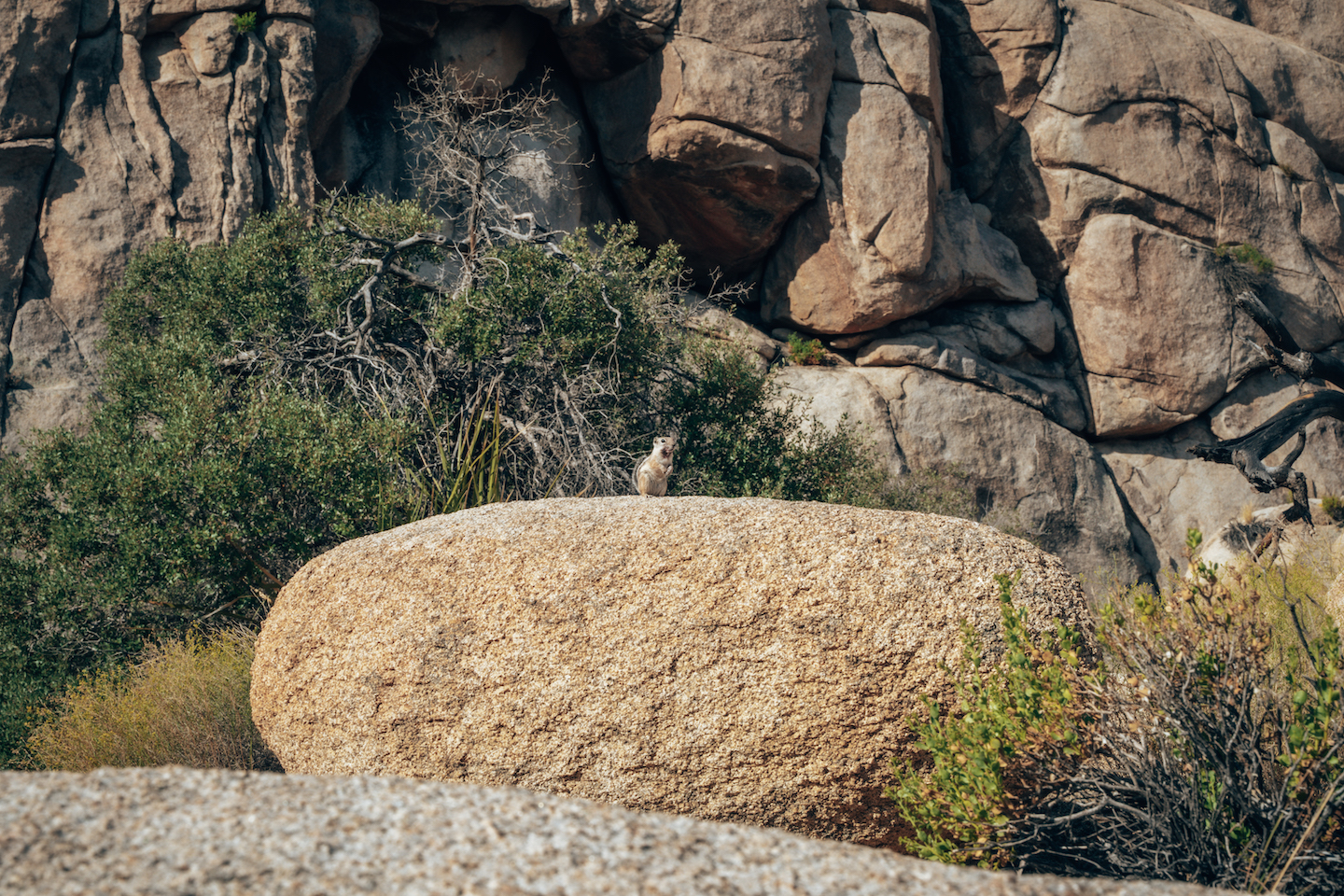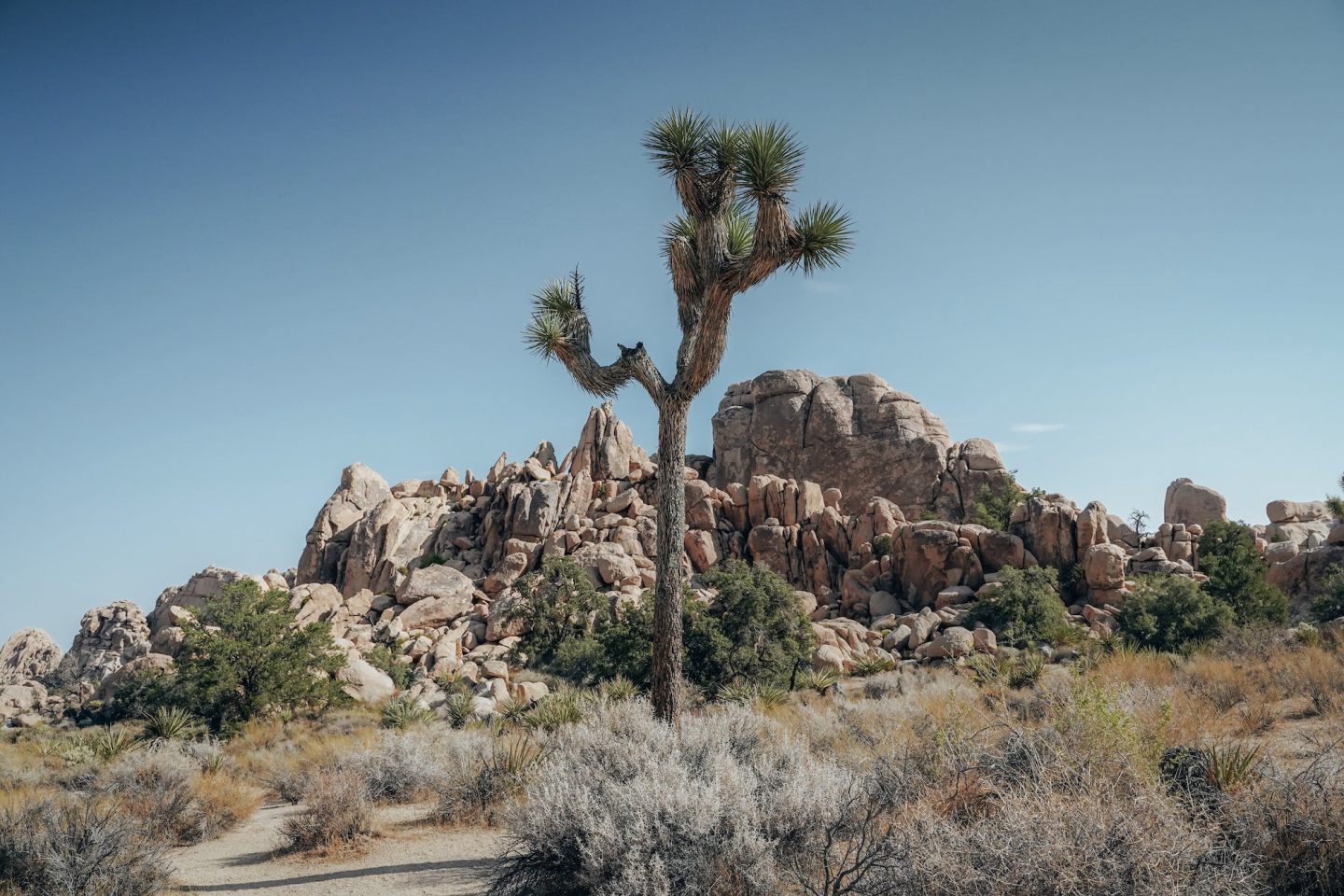
Extreme temperatures, dry desert, plants that can cause extreme pain, at first glance, one might question going to a place like Joshua Tree National Park. But we’re here to tell you, IGNORE ALL OF THAT. Vast mountains, luscious flora, super unique trees and plant life, oases, incredible night skies… There are a ton of reasons why you SHOULD go. So we’re going to focus on helping you plan your trip to Joshua Tree National Park.
- MAP OF JOSHUA TREE NATIONAL PARK
- JOSHUA TREE NATIONAL PARK: HOW TO PLAN YOUR VISIT
- JOSHUA TREE WEATHER
- BEST TIME TO VISIT JOSHUA TREE NATIONAL PARK
- ENTRY TO JOSHUA TREE NATIONAL PARK
- WHAT TO BRING TO JOSHUA TREE NATIONAL PARK
- WHAT TO WATCH OUT FOR
- HOW MUCH TIME TO PLAN FOR
- IS JOSHUA TREE NATIONAL PARK DOG FRIENDLY?
- THINGS TO DO IN JOSHUA TREE NATIONAL PARK
- WHERE TO STAY IN JOSHUA TREE NATIONAL PARK
- MAP OF CALIFORNIA
- JOSHUA TREE NATIONAL PARK: HOW TO PLAN YOUR VISIT
MAP OF JOSHUA TREE NATIONAL PARK
Joshua Tree National Park is located in southeastern California, where the Mojave Desert and the Colorado Desert converge. The park lies approximately 140 miles east of Los Angeles and about 50 miles northeast of Palm Springs, making it a popular destination for travelers seeking desert landscapes and outdoor adventure. The park’s entrance points are near the towns of Joshua Tree, Twentynine Palms, and Indio, with Highway 62 (Twentynine Palms Highway) serving as the main access route. This vast protected area spans over 1,200 square miles and is renowned for its iconic Joshua trees, dramatic rock formations, and diverse desert ecosystems.
Check out our map below to not only see exactly where Joshua Tree National Park and these activities are located, but over 500 other points of interest in California as well!
JOSHUA TREE NATIONAL PARK: HOW TO PLAN YOUR VISIT
JOSHUA TREE WEATHER
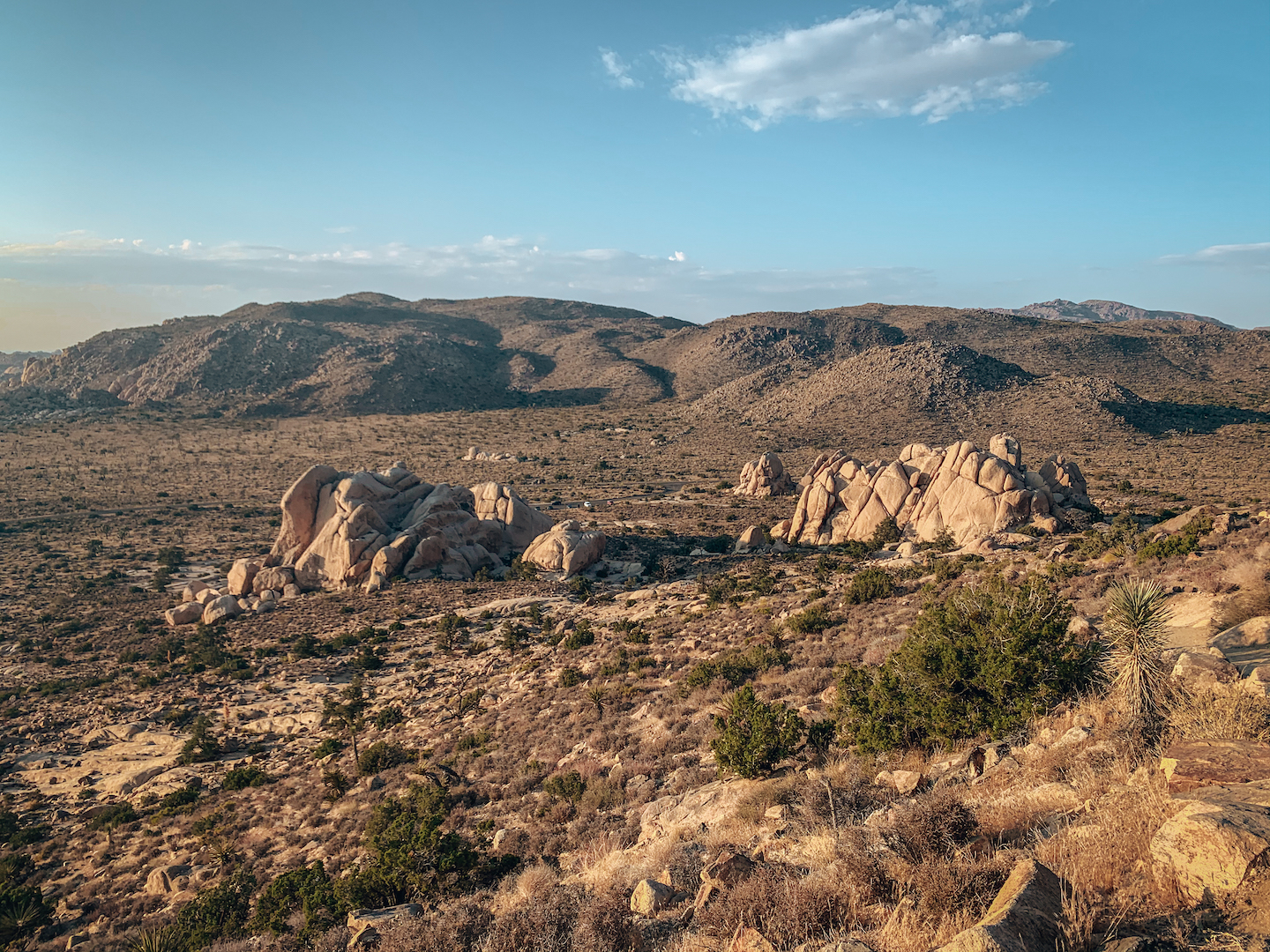
Joshua Tree National Park is considered a hot desert climate with temperatures easily reaching in to the 100ºs (F) during peak summer months. Between the low humidity/dry air, high temperatures, dirt and dust, it’s a place where you will need to stay hydrated through out the day. Especially if you plan to do any of the hikes. Despite being a relatively flat area, there are a number of mountains which have hikes taking you up to around 2,000ft. Combine all of these elements and you have yourself a place that can really have an impact on your body. So plan to bring plenty of water and sunscreen, and take plenty of breaks in between activities to rest and recover.

BEST TIME TO VISIT JOSHUA TREE NATIONAL PARK
We already touched on just how hot it can get in Joshua Tree, so if you are not a fan of super hot weather, then you may want to consider when you go. And despite being a place that gets as hot as it does, the temperatures can actually get quote low in the winter months (30ºF/-1ºC). When looking at just temperatures alone, our preference would be between March and May, or October and November. Temperatures are cool enough to be comfortable, but not cold enough to have to pack a ton of cold weather clothing. Unfortunately, these months also happen to be the peak months as a result of these moderate temperatures. So if you’re wanting to avoid crowds, then the hotter months may be better suited for you. Ultimately it is all based on what your wants and needs are.
ENTRY TO JOSHUA TREE NATIONAL PARK
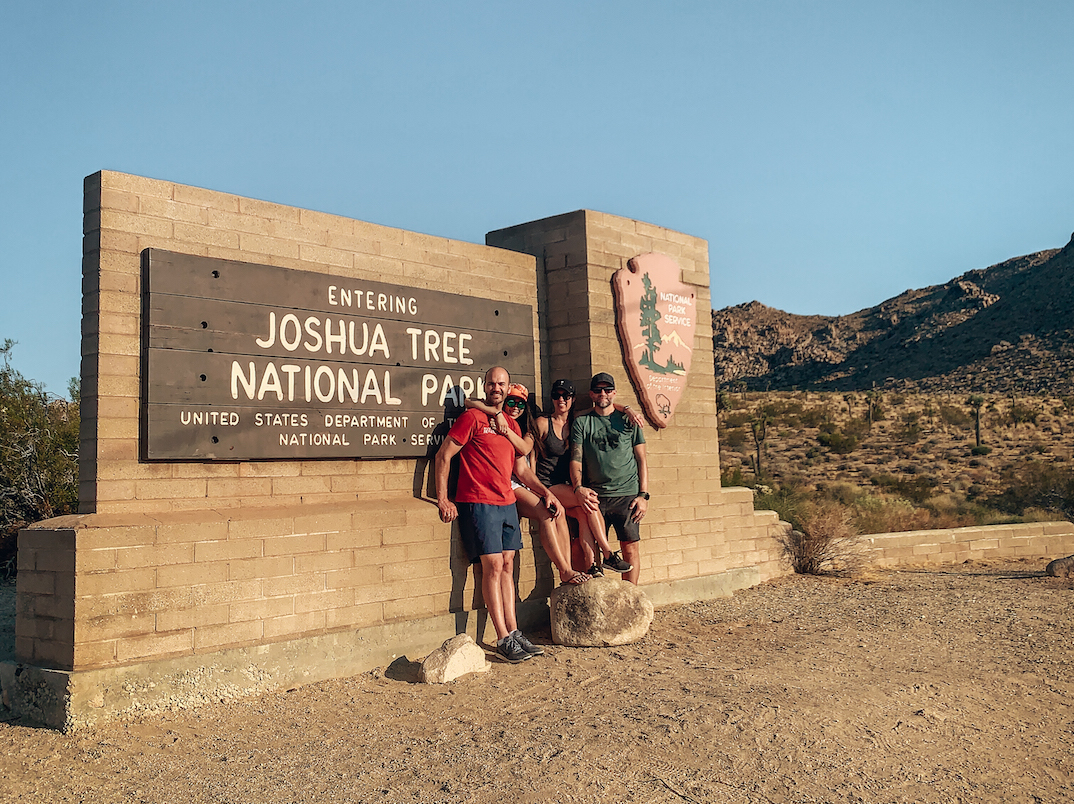
Being a National Park, there is an entry fee required. The good news, is not only is it not expensive, but there are also multiple options. A single vehicle pass is $30 and is good for 7 days from first entry. You can also get an annual park pass to Joshua Tree specifically for $55. But if you’re anything like us, and love visiting National Parks, you may want to consider getting the America The Beautiful Pass. This pass gives you free entry to all National Parks in the U.S. for just $80. They do also discounted Senior passes as well as free passes for current U.S. Military.
WHAT TO BRING TO JOSHUA TREE NATIONAL PARK
Depending on the month and season you visit, it could change what you need to bring with you. But there are some general basics that we think are must-packs and will make your experience much more enjoyable!
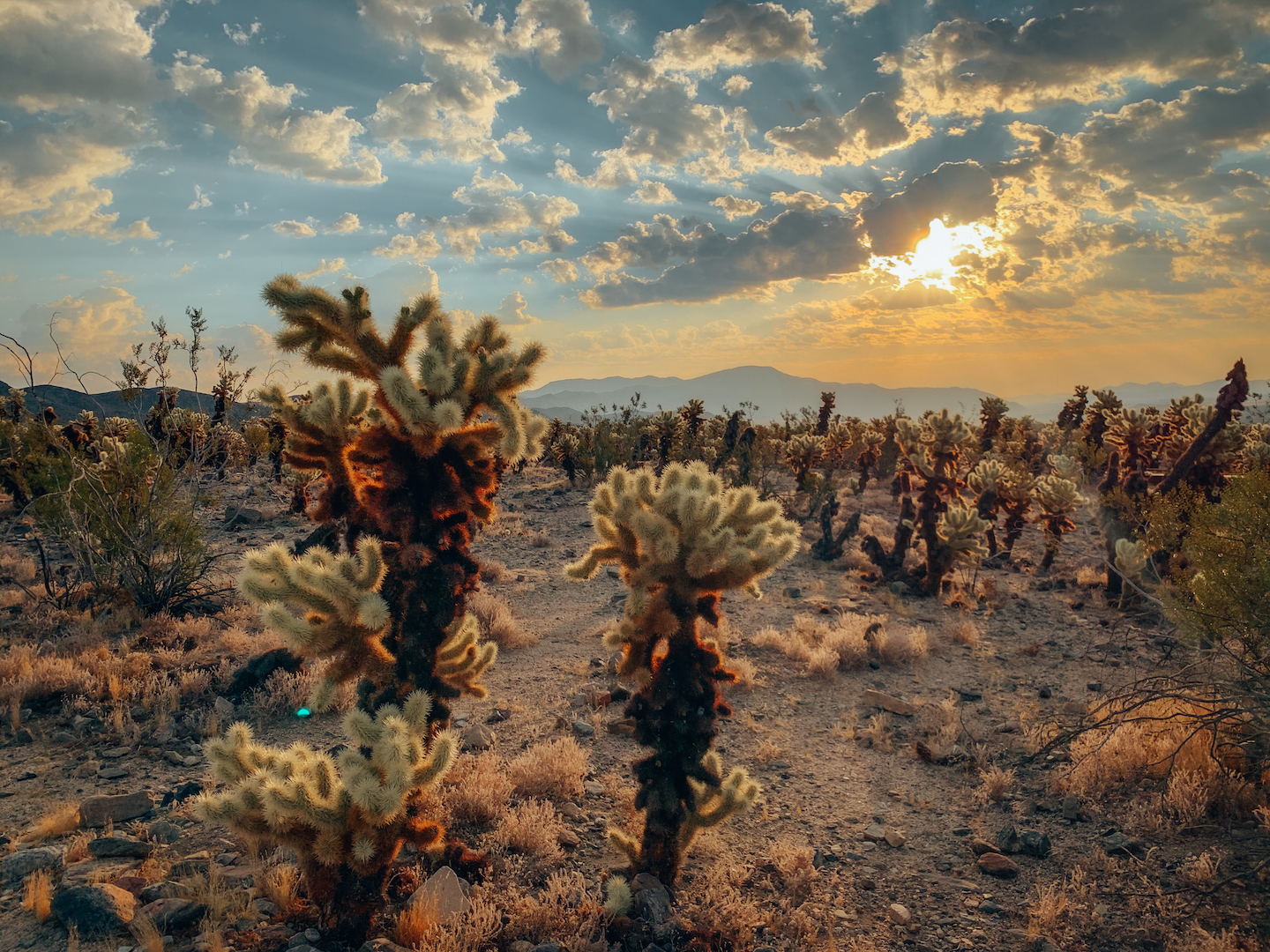
GEAR RECOMMENDATIONS
- Backpack / Daypack – Odds are you’re going to carry all of the below items in, so a good backpack or daypack like The North Face Recon is an absolute must!
- Water reservoir – For the longest time, we would pack both of our metal reusable water bottles in our daypacks, and not only did it add unnecessary weight, but it was also time consuming to stop and take our water bottles out of the backpack. We’ve since upgraded to the CamelBak Fusion 2L Reservoir, and it has been a game changer!
- Headlamps – Depending on how much time you spend on the hills, it could be dark out when you’re making your way back. That’s where headlamps come in handy. Our preferred and arguably the most popular, is the Black Diamond Spot 400.
- Hiking poles – Speaking of Black Diamond, they also make some of the best and most popular hiking and trekking poles. If you are someone who finds hiking to be easier with some extra stability support, then these are for you!
CLOTHING RECOMMENDATIONS
- Hiking boots – The type of footwear you wear, can literally make or break your hiking experience. We recommend a sturdy mid to high-ankle hiking boot like the Merrell Nova 3 due to some of the uneven rock and ground that you’ll be hiking on.
- Jackets & Layers – Layers are your friend. As you’re hiking around, your core temperature rises, and you’ll probably start feeling hot and sweaty. Then on the way back, the cooler temps as the sun goes down makes that moisture feel quite cool. So you’ll want moisture wicking layers like merino wool. Our personal favorites, are from Patagonia. Particularly their Capilene line.
- Socks – Speaking of merino wool, a good pair of merino wool socks will also go a long way in keeping your feet comfy, dry and let’s face it… Less smelly afterwards!
OTHER RECOMMENDATIONS
- Sun protection – Sun protection is crucial. Although we are recommending visiting when the sun is not at full force, it’s still incredibly important to bring proper sun protection for this park. We have found Sun Bum to be our go-to!
- Snacks – Whether you’re a chronic snacker like Katy, or just the casual when necessary snacker like me, it’s always good to have something on-hand just in case. A little protein can also go a long way in making your hike more enjoyable!
WHAT TO WATCH OUT FOR
Being a National Park, there are a number of different things to be aware of when entering and exploring the park. Despite being a hot dry climate, the park is home to an enormous amount of animals: bats, tortoises, lizards, snakes, bears, foxes, rabbits and hares… In fact, the park has 57 different species of mammals, 46 species of reptile, 50 species of birds and much much more. We found though that the most common that you’ll find are mice, kangaroo rats, rabbits and hares. So if you’re afraid of rodents, beware. Click here to read more on all the different animals in Joshua Tree.
CHOLLA CACTUS
We found that plant life can actually be the most dangerous. One in particular: the Cholla Cactus [pronounced “choy-ah”]. If you really want to get a sense of how dangerous these plants are, just do a quick youtube search of Cholla Cactus, and you will find a plethora of videos of people being “attacked” by these super interesting plants.
When looking at this cactus, it looks like what you would expect from a cactus plant. Lots of needles. But what you don’t know, is just how dangerous these needles are.
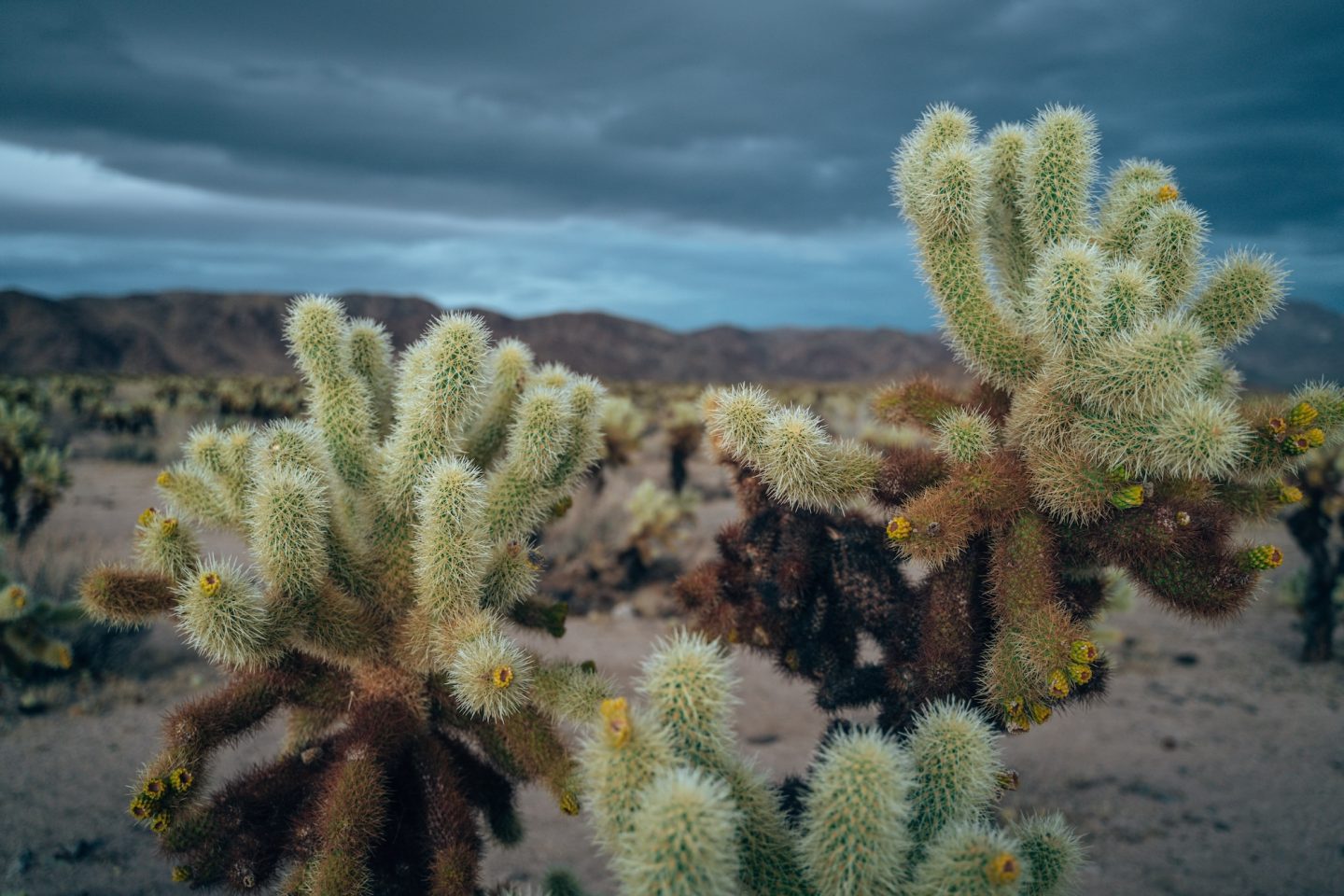
First of all, each little bulb or leaf which is covered in needles, can easily fall off and on to the ground. One might think that simply wearing good shoes or hiking shoes would be sufficient, but what you don’t know is that the needles on these “leaves”, can go right through the soles of your shoes and in to your skin. If that’s possible, imagine what they can do when they come in contact with your exposed skin. And once they’re in, they do not come out easily. Each needle, is covered in hundreds of micro-needles, so when you attempt to pull these out, which is near impossible mind you, the needles pull. And then they dig in deeper.
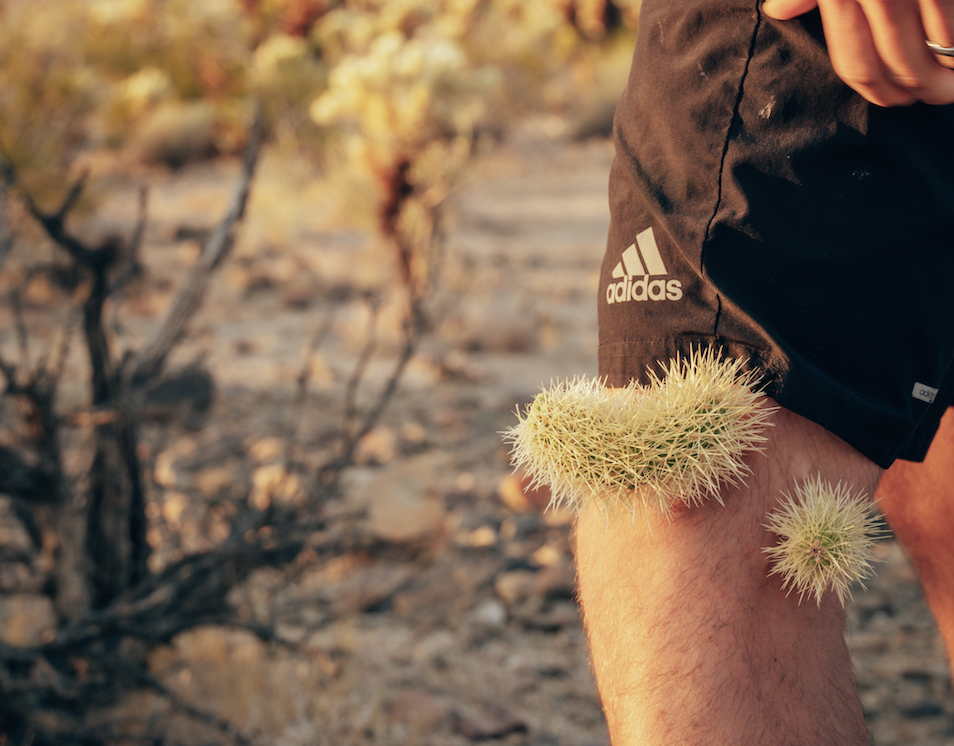
So, our recommendation, if you’re going anywhere near these things, watch every one of your steps, wear really good shoes, and wear thick pants. You’ll thank us later. Trust us.
HOW MUCH TIME TO PLAN FOR
Joshua Tree is the 15th largest National Park in the U.S., so there’s a fair amount of ground to cover. One of the beauties of the National Park though, is just how accessible everything is. Park Blvd and Pinto Basin Rd are really the only two roads through the park, which connect in the middle. And depending on just how much you want to do, will really dictate how much time to plan for. We ultimately spent two full days in the park and were able to cover a good amount of ground. You could do a single day trip in the park and do a lot though. In fact, we have a whole article on what ONE DAY IN JOSHUA TREE NATIONAL PARK CALIFORNIA would look like. But it would require mid-day hiking and exploring, which we would not recommend, especially during the hotter months. Our recommendation, a minimum of two day, and a maximum of four to five.
IS JOSHUA TREE NATIONAL PARK DOG FRIENDLY?
While the park offers incredible opportunities for hiking, climbing, and stargazing, its dog-friendly policies are limited due to the delicate desert environment. Dogs are allowed only on paved roads, picnic areas, and campgrounds, but they are not permitted on hiking trails or in the backcountry. This is to protect both the fragile landscape and your pet, as the desert’s sharp rocks, high temperatures, and wildlife can pose risks. For dog owners, the park still provides plenty of scenic, pet-friendly spots to explore by car or while walking along paved areas. Always remember to keep your dog leashed and bring plenty of water to keep them comfortable in the arid climate.
THINGS TO DO IN JOSHUA TREE NATIONAL PARK
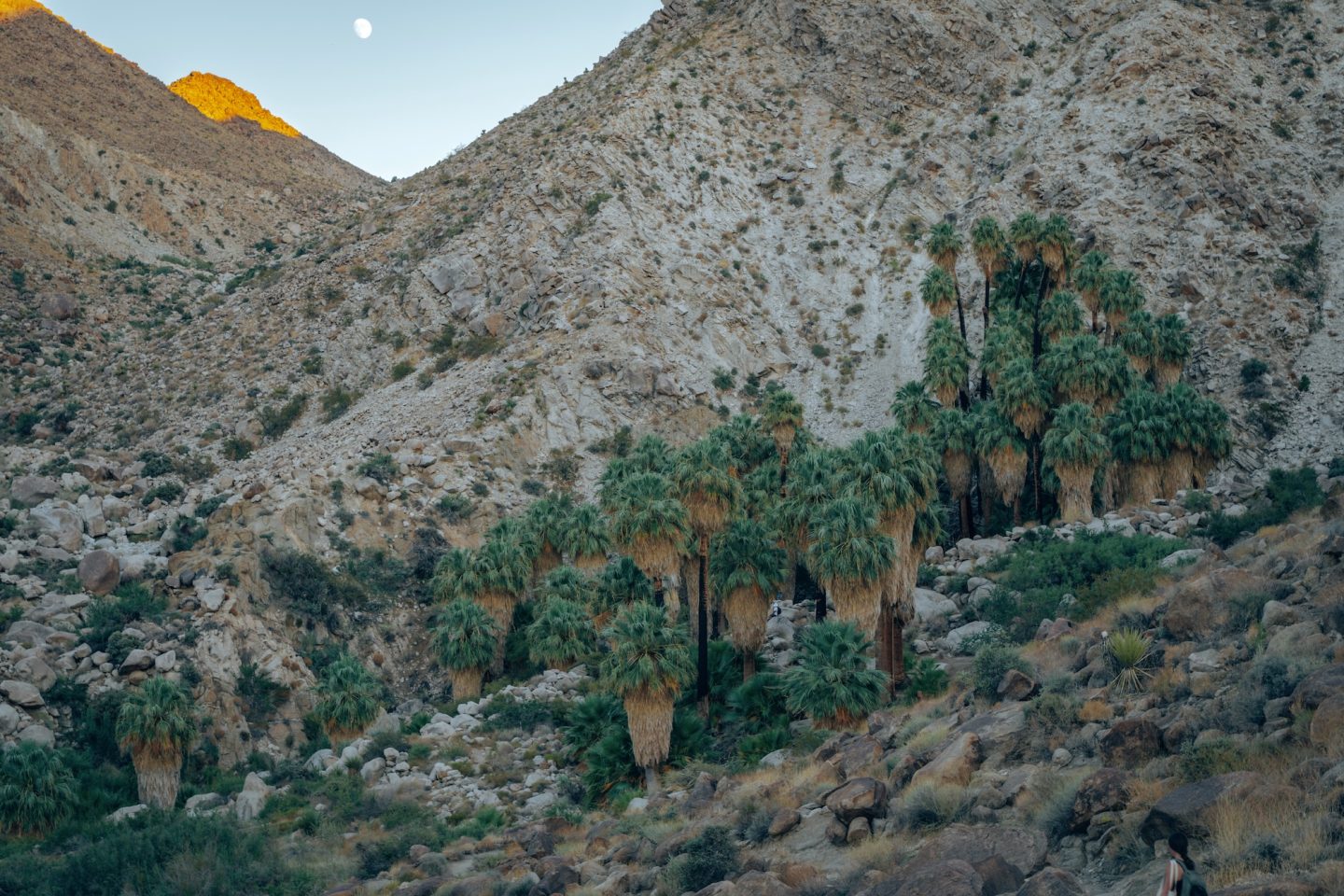
Joshua Tree National Park offers hiking, rock climbing, and stargazing. Explore scenic trails like Hidden Valley and Barker Dam. Visit Skull Rock for unique photo opportunities. Rock climbers enjoy the park’s famous granite formations. Drive through the Cholla Cactus Garden at sunset. Camp under clear desert skies for incredible stargazing. Don’t miss Keys View for sweeping desert and mountain views. The park is perfect for adventure, photography, and nature lovers. For an in-depth look at things to do in Joshua Tree National Park, check out our 5 MUST-DO ACTIVITIES IN JOSHUA TREE NATIONAL PARK article.
WHERE TO STAY IN JOSHUA TREE NATIONAL PARK
Joshua Tree National Park actually has 9 different campgrounds within the park that you can stay at. Many of these are first come first serve. But between the months of September and May there are a number where you can reserve a spot. The campgrounds do have fees ranging between $15 and $25 per night, even for the first come first serve locations. Many of the grounds have at least pit toilets, tables and fire grates, while only a few have water and flush toilets. Additionally, there are a number of restrictions and regulations for these campgrounds depending on time of year. So make sure you read up on them before planning your trip.
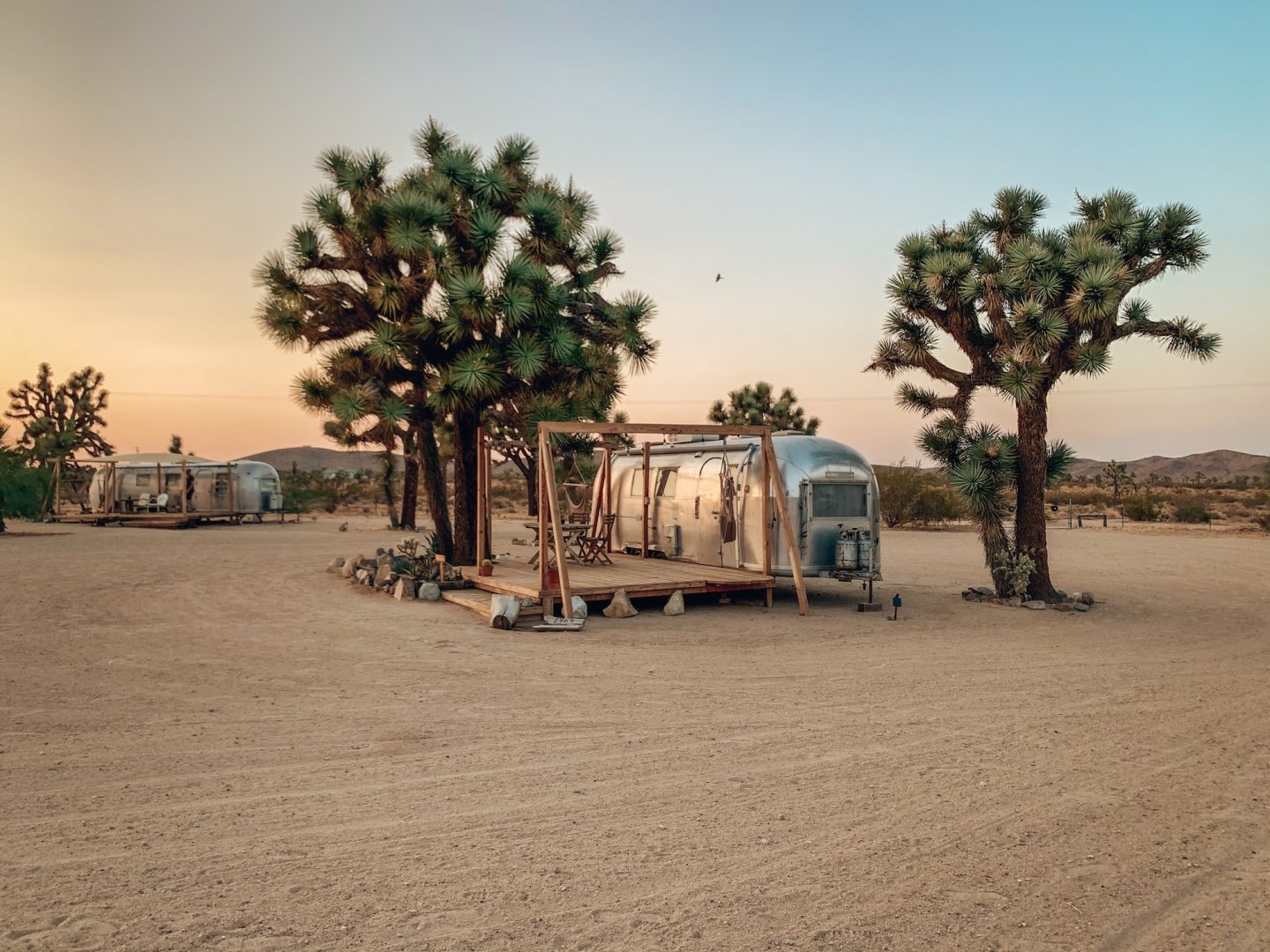
HOTELS NEAR JOSHUA TREE
Outside of the park there are plenty of places to stay within a 10-20 minute drive of the park. Along the 29 Palms Highway which runs parallel to the north side of the park are a number of hotels, motels and inns. You’ll also find a plethora of unique places to stay in nearby Palm Springs and Palm Desert.
MAP OF CALIFORNIA
Want to see ALL of the different things to do in Joshua Tree National Park in California? If so, this map is for you. Not only does our interactive map of California have ALL the details and location info for the activities in this article, but it also has over 500 other points of interest in California in it. With all of the location specific details and information like GPS location, dog-friendliness, cost, and more, as well as an itinerary creator, this map is the perfect trip planning companion.
JOSHUA TREE NATIONAL PARK: HOW TO PLAN YOUR VISIT
Joshua Tree National Park offers an unforgettable experience, whether you’re hiking through its iconic landscapes, exploring hidden oases, or simply soaking in the serene desert beauty. With a variety of trails suited to different skill levels, there’s something for everyone to enjoy. From the striking Arch Rock to the panoramic views atop Ryan Mountain, each adventure leaves you with memories of this unique desert wonderland. Whether you’re a seasoned hiker or a casual explorer, Joshua Tree’s magic will leave you wanting to return and uncover even more of its stunning terrain.
We hope this helped give you some insight, and ultimately helps you plan your own visit to Joshua Tree National Park. If we missed anything, or you have any other recommendations, let us know below!Head over to our 5 MUST-DO ACTIVITIES IN JOSHUA TREE NATIONAL PARK for more inspiration!
And if you aren’t following us on Instagram, check us out there for daily California inspiration!
Thanks for stopping by! – Ryan & Katy

